Fans of Japanese fountain pens will undoubtedly have heard if the legendary Cross nibs from Sailor. In their current incarnation, Sailor offers the Cross Point, a slim but long 2 layer NAG-like grind, the Cross Music, a 2 layer Architect-like grind, and the Cross Concord, a reverse NAG-like grind.
In the past, 3 layer grinds such as the King Eagle and the underside welded King Cobra have also been produced.
As the story goes, Nagahara Nobuyoshi (Senior), Sailor’s nib designer who played a large part in popularising the NAG, was on a business trip in Tokyo in 1996. According to Moriyama of Fullhalter, Nagahara wanted to make a drawing nib for an artist when the idea came to him on one of those Tokyo nights. Seized with inspiration, Nagahara worked through the night until, in the morning, he had completed his first Cross nib. That day, Nagahara called Moriyama from a department store in Nihonbashi, saying “I made something amazing and I want to show it to you so come over now!”
Moriyama, a legendary nib worker and his own right, writes on his blog that his encounter with the Cross nib had a lasting impact on his relationship with fountain pens. It had opened up the world of fountain pens even further for him, and he calls the Cross nib the ultimate expression in broad nibs.
Indeed, Moriyama dedicates a large portion of his website to singing the praises of the Cross nibs. In one article, he writes about the 3 generations of stacking techniques, which he calls old, zure (shift), and new. It certainly is interesting to see how the “hook” style of stacking nibs was developed.
In recent years, some nib workers across the world have popped up and started welding nibs in the both the style of the Cross nibs, as well as new innovative styles.
Of the ones that I know, in Japan there has been Yamada-san, of Wagner, doing experiments mainly with Pelikan nibs. His creations, though interesting, are monstrosities that do not particularly match my fancy.
In Taiwan, there is Mr Tommy Zheng, who had at one point in time had supposedly trained with Nagahara Senior. His stacked nibs range from steel Jowo nibs to gold nibs, and are largely the same style as Nagahara Senior.
Pablo of fpnibs.com also stacks nibs. He cuts the tines into 2 pieces, but flat across. It really gives a nice layered look. As far as I know, these nibs are not for public sale.
In the USA, there is currently Pen Sloth, who likes to experiment with big shapes and tipping. The welding is done in a way that cuts the tines into one single piece, and then is welded onto the base nib. While the welding is not the cleanest, he does make interesting shapes and I appreciate that.
Monty Winnfield makes some of the most beautiful welds and really structurally interesting shapes to accompany them. His work is so far limited to steel nibs, as far as I know, but they deservedly fetch a pretty penny.
Gena of Custom Nib Studio had crowdfunded for a welder in 2020, and the world awaits her fabulous creations.
And of course, one cannot talk about stacked nibs without talking of Ralph of Regalia Writing Labs. I want to separate Ralph from the rest of the above due to the sheer genius of Ralph’s creations. Ralph was, as with many of us, inspired by Nagahara Senior’s insane creations. Out of a longing for more interesting nibs, Ralph decided to make his own, and from his mind was born wonders like these below.
Indeed, Ralph was a very important inspiration for my own becoming of a nib worker. His creations lit a curiosity inside of me that burns to this day. While I have been working on nibs in a semi-professional manner for the past 2 years, I have yet to create a stacked nib… until now.
I had 2 Montblanc 146 nibs retipped by Greg Minuskin in order to undertake this process, and the nibs made their way to me early last year. However, I was torn between asking a jeweler to do it for me versus taking the chance and doing it by myself. This hesitation lasted almost an entire year, which shows how nervous I was about this project!
In order to make this work, I had to make sure that I understood how the nibs should layer. As Moriyama’s website makes clear, there are 3 different ways to layer. Most welders that I have listed above are layering the nibs using the “old” method. This means that they grind the tipping of each nib flat in order to have a clean stack. Only Pen Sloth has left the tipping unground as far as I can see.
However, Sailor does 2 unique things that make their way of layering superior in my opinion.
The first is the “new” layering method, where the top layer actually hooks onto the bottom, or vice versa. This gives the nib a really brilliant and juicy tip, and I think it just looks more aesthetically pleasing. It also benefits from preserving the most tipping of the 3 methods.
The second is the way that they cut their tines. Sailor cuts the tines in a reverse V shape, which means that, when unwelded, there are 2 tiny pieces of tipped gold floating around the workspace. This means that the welding is much more difficult, because you need to make sure that the top tines are perfectly aligned to the bottom tines. You also need to ensure that the top tines are aligned with each other, because it is very easy to make a weld that results in a tine gap between only the top tines. If this happens, it is impossible to reverse, so you will have lost those nibs. Indeed, I have seen some older Sailor nibs with said tine gap, and it will cause scratchiness when writing.
I, not realising the difficulty, opted to do both of these very complex tasks.
The first thing to do is to make sure that the tipping fits on top of each other in a hook. This is probably the most important step because it the nibs do not hook, then they will not be able to form a beautiful cross shape after the weld. Cutting the hook itself is a herculean task without the right jigs. I did not use any jig, and was very much struggling with getting the hook correct by eye. In the end, I managed to get a fairly acceptable hook.
The next process is to cut the tines. As the nib I cut was a Montblanc 146, the tines were imprinted clearly with 3 distinct sections. I cut off the tines and shaped it until I only had the outer section left, creating the upper tines that I would need to weld onto the bottom nib.
Now, one of the most daunting, and exciting, parts is the actual welding. I bought a fairly affordable non-gas welder on Amazon. The machine cost around 200USD. It came with a tweezer that attaches to the machine, a stand, an argon pin that would be point of welding, and a foot pedal that activates the machine.

I practiced on a set of Kanwrite steel nibs and some scrap gold nibs in order to get into a good flow. With steel nibs, I noticed that not only did I have to tune the power of the welder up a lot more, but that the steel did not weld as cleanly as gold. After I welded the steel together, the steel warped in such a way that the tines splayed away from each other.
With gold, this problem did not exhibit, though the power must be dialled down greatly at risk of simply blowing a hole in the material.
Once I got to a comfortable power, I managed to weld 2 sailor nibs together at the end. They look like clumps of molten gold at first, indeed that is what they are.

Although the weld face is bumpy, I found that by grinding down and polishing, I could get a relatively smooth surface.
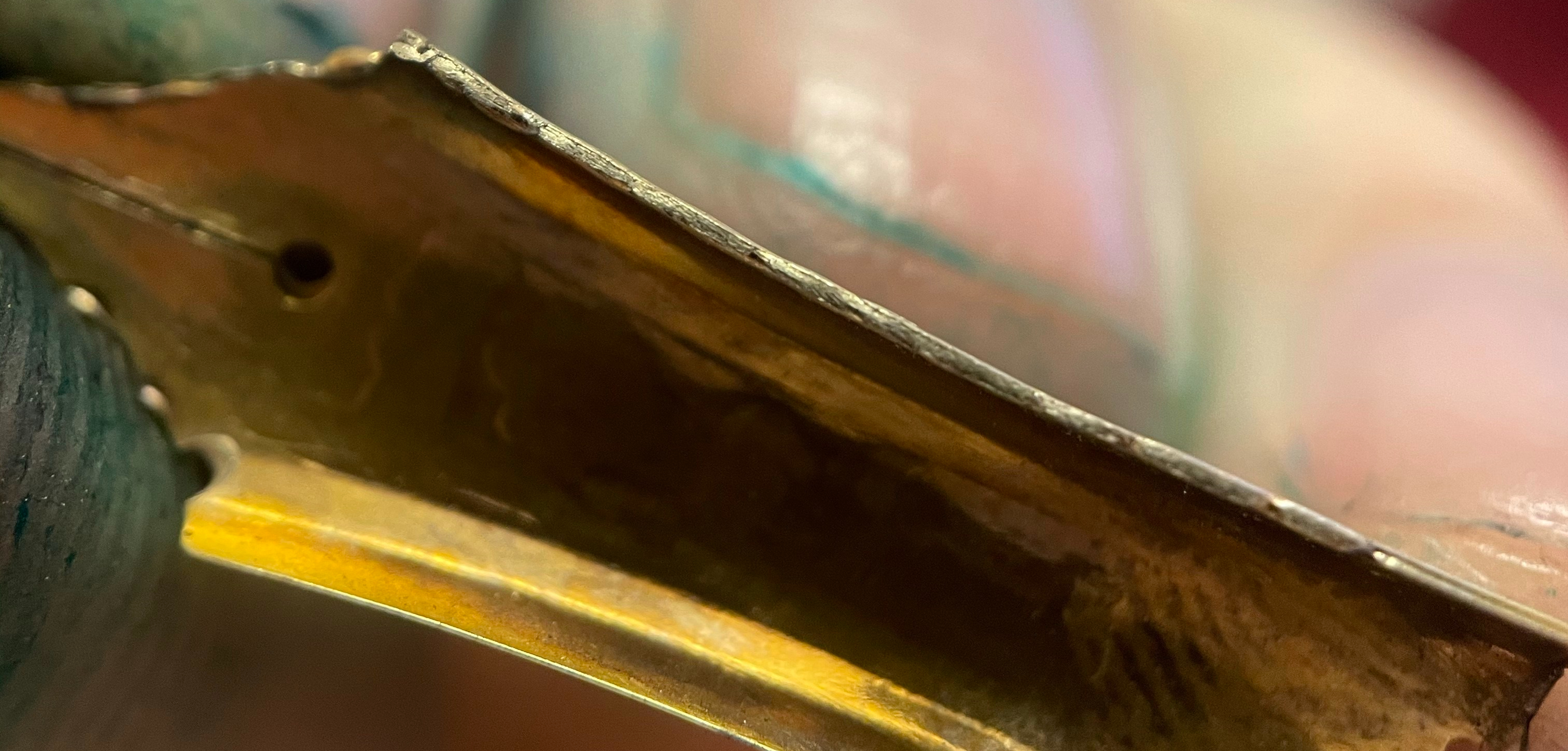
Now that I had successfully performed a weld on the nibs, I decided that it was time to try it on a nib.
I took the nib and held the upper tines with the tweezer, being very careful to align the upper tines and lower tines from the tine slit. Using my welder, I weld a single spot, strong enough to hold the upper tine in place, but weak enough to be shifted and moved if necessary. Then, aligning the second tine. If not careful, the upper tines could end up with a gap, as can be seen in the below examples of the King Eagle. If this gap develops, then it becomes impossible to create a sharp tip and renders reverse writing an unpleasant experience.
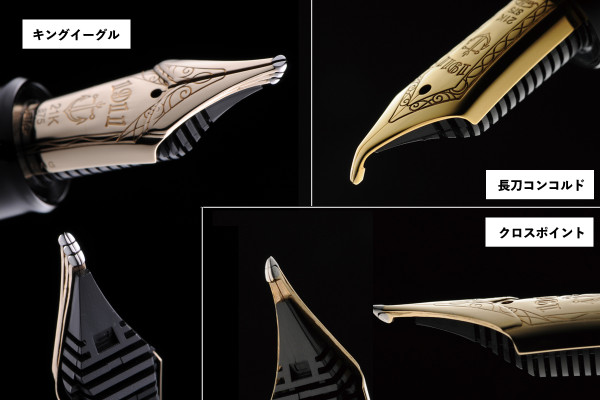
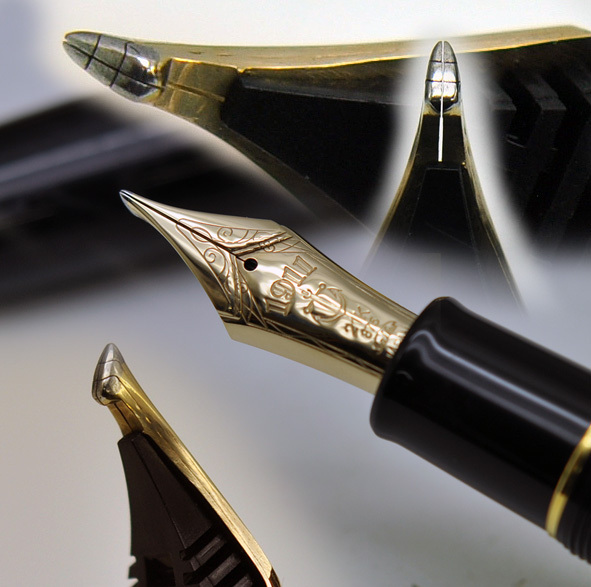
Ultimately, I managed to weld the upper tines in place, and having moved them so that the 4 tines aligned to my satisfaction, I completed the rest of the welding so that the welds would be strong enough to keep the nib stacked, even with heavy use.
Once the welds were formed, the next step is to grind down the weld face into a smooth surface. The weld face formed even on top of the second tine, so I carefully ground the welded parts down to the desired shape. After this process is complete comes the actual grinding of the nib into a NAG. The result? A wonderfully extra wet two layered nib. In honour of Ralph and as tribute to his inspiring work, I am naming my 2 layered NAG as “Regalia”.
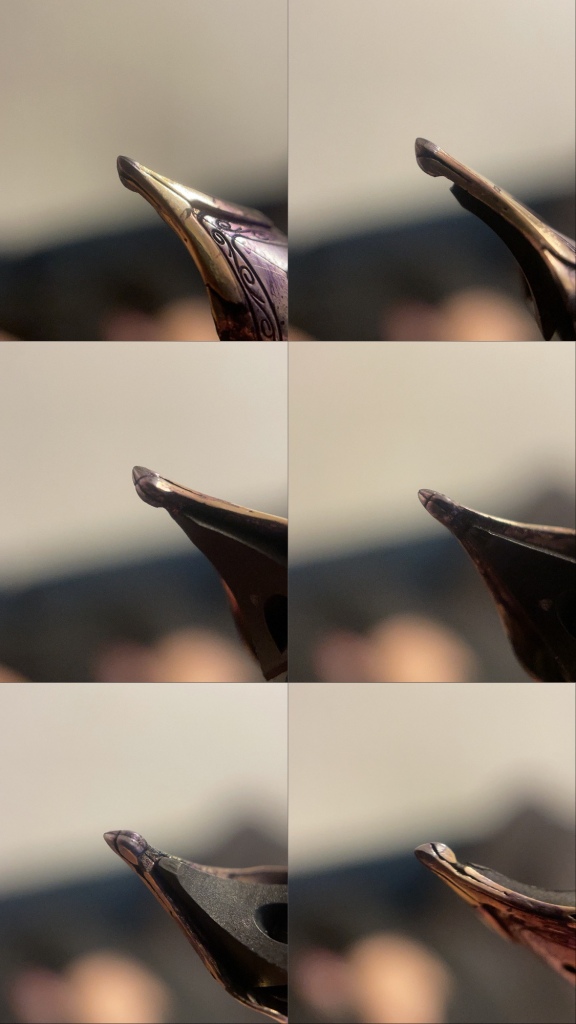
I am very happy with this result, but I do also want to take a minute to reflect upon the differences between my nib and Sailor’s Cross nibs. So I took some macro photos showing the side by side comparison between my Cross Point that I ground into a Cross NAG.

As you can see, Sailor has really perfected the art of stacking nibs. The gap between the tines are hairlines, showing a tight fit on the “hook”. In comparison, my nib has a wide gap, due to not having prepared the hook as well as Sailor. On top of this, Sailor’s cross is extremely clean. My cross is slightly skewered to the right (left on the photo), and therefore not a perfect cross. Nonetheless, this does not impact the writing performance. If anything, this makes the nib even more wet than the Sailor version, and is probably closer to what Nagahara Senior had made during his time at Sailor.

I have installed the nib in a heavily customised Montblanc 146, which I intend to further “improve”. Even as is, it’s a beauty to behold.
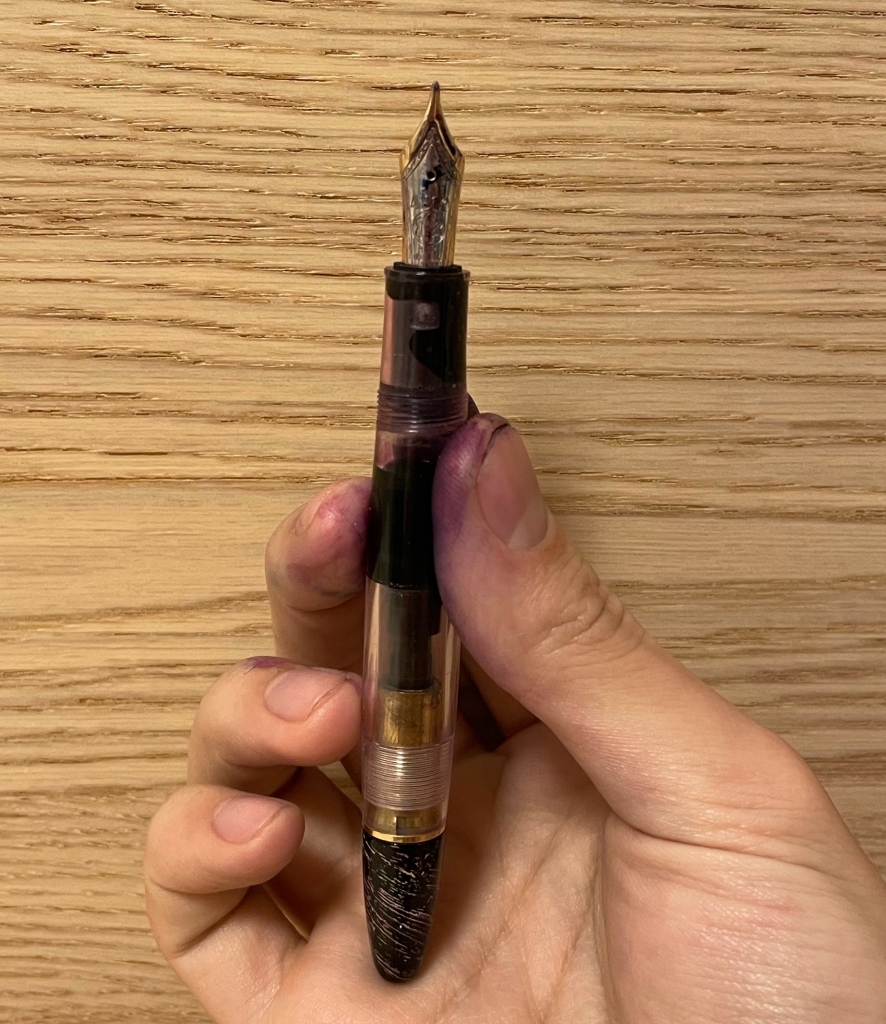
This nib is a true ink guzzler. I took it into the office on Monday and even with the capacity of a piston filler that usually takes weeks, if not months, to empty, the Regalia drained the pen within a single day’s use.

Given the rarity and difficulty of stacked nibs, it’s no surprise that I got a deluge of inbox messages inquiring about the price of a commission. Although I have not decided on any pricing for stacking nibs yet, it will definitely be very high. Even if I decided to sell this nib, I would have to sell it for more than 1,000 USD if I wanted to break even. Using less expensive nibs such as Pilot C, Platinum C, and Sailor Z nibs would bring down the price to a certain extent, but still remains in the “very expensive” realm.
What do you think of stacked nibs? Have you ever tried one? Would you ever want to try one? Would you ever want to own one? Let me know in the comments!
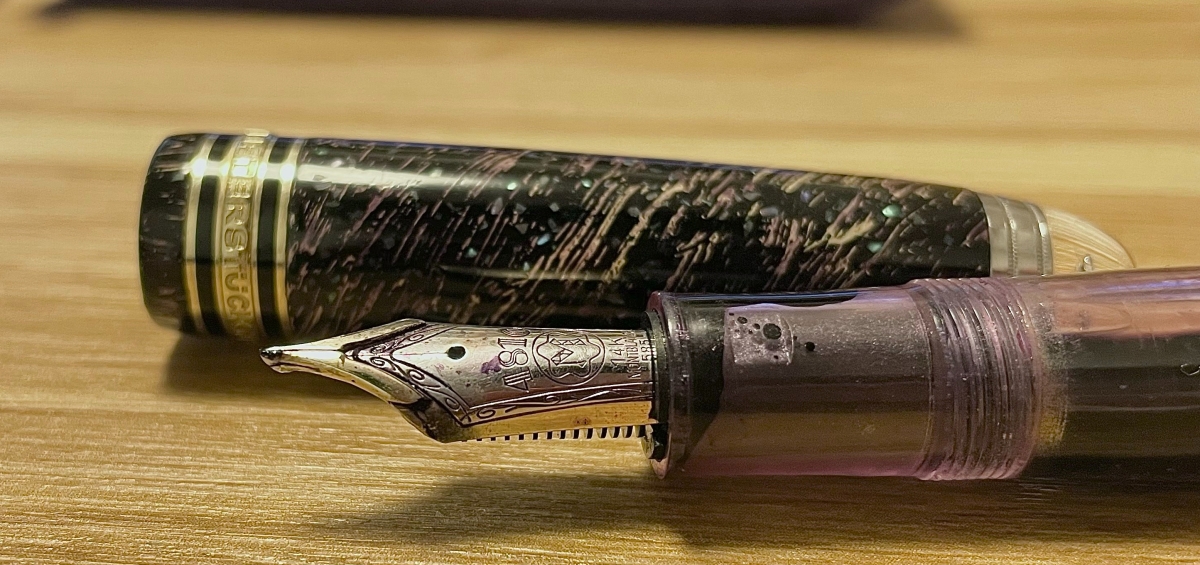
13 replies on “The Anatomy of a Stacked Nib”
Great artical. I want to learn this art. I would really love of watch a detailed video tutorial on this. I would even buy if such tutorial is available on any VOD sites.
LikeLike
Maybe one day I’ll have the time to show this
LikeLike
A surprisingly educating essay. I still haven’t decided how I feel about these nibs. I’m not the one to exaggerate the importance of western market, especially in this field where Japan and China alone easily cover half of the sales, but I still believe that whoever comes up with a nib suitable for roman script will be the next big thing. As it stands right now, there are people willing to pay for craftsmanship and bragging rights, but there are even more that find a 600$ Sharpie/brush pen imitation an impractical purchase. It’s also why I’m placing my hopes in Chinese brands to drop the prices significantly enough, that the more established brands might attempt to venture into it with their steel nibs. Or at least that’s what I would say, if we didn’t have a full fledged trade war on top of an economic crisis right now, so…yeah. Don’t expect much in that regard.
LikeLike
Thanks! Id argue that many many more people would consider spending more than 5$ to be outrageous and impractical. These nibs, ultimately, are an expression of the pen and creates possibilities otherwise impossible. For me, that is the appeal. I dont necessarily agree that chinese brands dropping the prices would be a positive thing. Being on the making side, i understand where the costs are and i think that Sailor’s pricing for the stacked nibs are actually fairly reasonable. If Chinese brands price us out, then we makers and creatives would be out of our revenue stream.
LikeLike
Agreed. Still, the supply/demand rule dictates where the market will go. We’ve already seen it in urushi services, with 2nd echelon companies popping up outside Japan, as well as couple folks doing Chinese lacquer treatment at the lower price spectrum. Just as much, independent nib makers emerged largely in response to Sailor’s seemingly outlandish prices on specialty nibs. There’s certainly room for further “optimisation”. Swap Jowo for Jinhao, artists for workforce and ignore a couple customs laws, there you have your price cut. I can easily imagine someone like Tramol or Moonman releasing a couple test batches to see if there’s demand.
LikeLike
Sure, and there are some “italian style lacquer” that you can find in certain facebook groups. The question always is quality and craftsmanship
LikeLike
I cannot read this post. Ugh such BLOAT! BLOATED WordPress hosting images from more soul-sucking Instagram BLOAT – gee why don’t you add a big fat dollop of Squarespace BLOAT on top of this stinking pile of excrement? Please learn how to publish online, lean and clean is the way, please!! I doubt this comment will post, this is already starting to feel like underlying WordPress Jetpack BLOAT, perhaps with some added Google reCAPTCHA BLOAT as icing on the cake.
LikeLike
Thanks David. I find your comment particularly unpleasant. It’s unfortunate that you could not enjoy the article because of all the BLOATED images. Most of my readers enjoy having image references.
Given that you do not seem to be very internet savvy (nor English savvy by the looks of your grammatical composition), David M. R. of Florida, forgive me for not taking internet and media advice from you.
LikeLiked by 1 person
I’m sad to read your reply. I like how you write and what you write about; but the way it is presented online makes me cringe. All else aside, I wish you good luck. Good bye.
LikeLike
This is utterly fascinating me but I am also wondering if there is anything one can do with this other than an oversized version of coarse/zoom/architect/naginata?
Second question: are the only ways to stack limited to hot welding or soldering? Is metal glue not an option?
Final nitpicky remark: calling a Naginata Togi “NAG” feels a bit disrespectful (in my ears) to this craft, as it is not just a Sailor trademark but also a callback to an honoured Japanese cultural piece of history. It’s not an acronym or a nagging thing, so I think a quick search&replace on the article is an easy fine-tune worth performing…
LikeLike
Thanks for the comment.
I’m sure that depending on the way that you stack them, you can come up with many variations. Ralph in particular was a leader in that kind of design.
Some stackers have used epoxy. I prefer welding because it makes the meta a singular piece structurally, not two pieces put together.
Finally, “NAG” was the Sailor designation for all Naginata type nibs. It’s the original way to call these grinds, and not particularly anything to do with the actual Naginata swords (that the first generations were inspired from, but bore little resemblance when compared to the latter/modern iterations). Anyway, they are referred to as NAG because that was how they were designated by Nagahara Sr and Sailor when it was first created!
LikeLiked by 1 person
brilliant article that explores the depths of these amazing and unique nibs. A source and wealth of infomation thank you
LikeLike
Thank you! I’m glad you like it!
LikeLike